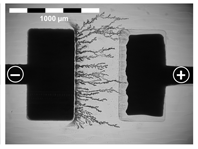Article contents
Lifetime limitations in organic electronic devices due to metal electrochemical migration
Published online by Cambridge University Press: 19 July 2017
Abstract

Operational lifetime is a critical performance parameter of organic electronic devices and can be cut short by multiple degradation mechanisms. One supposed cause is metal migration between the electrodes, which, however, is difficult to study independently of other failure modes. We present a setup, which excludes such competing processes and demonstrates that silver (Ag) electrochemical migration through organic optoelectronic materials occurs predominantly by cation transport. Metal dendrites form at the cathode, eventually causing short circuits between the electrodes. Lifetime studies with organic light-emitting diodes containing Ag electrodes suggest that results obtained with our setup can provide relevant information about degradation in real devices.
- Type
- Research Letters
- Information
- Copyright
- Copyright © Materials Research Society 2017
References
- 3
- Cited by


